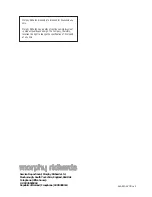
15
Creating your own yeast breads
With the Morphy Richards Breadmaker, even the
most inexperienced baker can achieve the satisfying
experience of baking a loaf of bread. All of the
mystery and hard work is gone. Inside this machine,
the dough is mixed, kneaded, proved and baked
without you being present. The Breadmaker can also
just prepare the dough, and when it's ready, you shape
and bake in a conventional oven. The recipes on the
following pages are ‘tailored’ for this Breadmaker.
Each recipe features ingredients that best compliment
a particular loaf of bread. It is extremely important not
to exceed the amounts of flour specified in each of the
recipes or else it could result in unsatisfactory baking
performance. When creating your own yeast bread
recipes or baking an old favourite, use the recipes in
this cookbook as a guide for converting portions from
your recipe to your Breadmaker.
Dough - Setting 9
• Place all recipe ingredients into the baking pan so
that yeast is not touching any liquid.
• After completing the process of making dough in
your Breadmaker, remove it from the machine.
Please refer to individual recipes for further details
on rising and baking, as recipes may vary.
• The DOUGH setting is great for mixing, kneading
and proving (allowing dough to rise) richer dough
like croissant doughs. Use the Breadmaker to
prepare this dough so all you need to do is shape
and bake it according to your recipe.
• When recipes call for a ‘lightly floured surface,’ use
about 1 to 2 tablespoons of flour on the surface.
You may want to lightly flour your fingers or
rolling pin for easy dough manipulation.
• When you let dough ‘rest’ and ‘rise’ according to a
recipe, place it in a warm, draught-free area. If the
dough doesn't double in size, it may not produce a
satisfactory product. Dough is ready when an
indentation remains when it is touched.
• If the dough you are rolling shrinks back, let it rest
covered for a few minutes before rolling again.
• Dough may be wrapped in plastic and stored in a
freezer for later use. Bring the dough to room
temperature before using.
Making more than one loaf
If wishing to bake more than one loaf, ensure the
Breadmaker cools sufficiently prior to starting the next
cycle. Also ensure that the baking pan and kneading
blade are clean and dry before starting the next loaf.
Special glazes for yeast breads
Give your just baked bread a professional finish.
Select one of the following special glazes to enhance
your bread.
Egg Glaze
Beat 1 large egg and 1 tablespoon of water
together, brush generously (Note: apply only to
doughs before baking).
Melted Butter Crust
Brush melted butter over just baked bread for a
softer, tender crust.
Milk Glaze
For a softer, shiny crust, brush just baked bread
with milk or cream.
Sweet Icing Glaze
Mix 1 cup sifted icing sugar with 1 to 2 tablespoons
of milk to make a consistent glaze, drizzle over Raisin
Bread or Sweet Breads.
Poppy/Sesame/Caraway Seed/Oatmeal
Sprinkle your choice of these seeds generously over
just glazed bread.














































